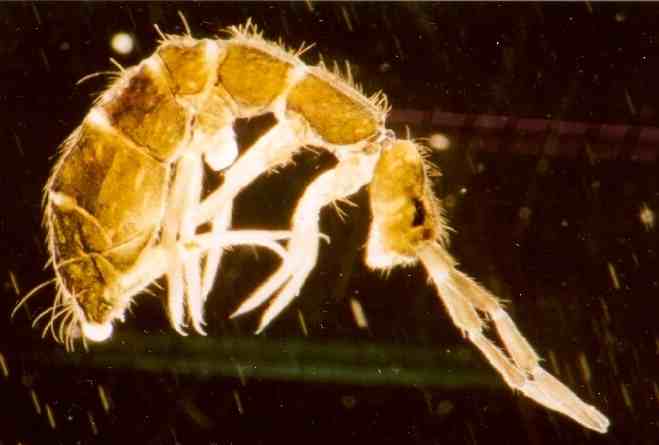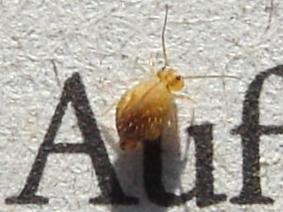|
Entomobryomorpha
The Entomobryomorpha are one of the three main groups (order) of springtails (Collembola), tiny hexapods related to insects. This group was formerly treated as a superfamily, the Entomobryoidea. They can be best distinguished from the other springtail groups by their body shape. The Symphypleona are very round animals, almost spherical. The Poduromorpha are also very plump but have a more oval shape. The Entomobryomorpha, by contrast, contain the slimmest springtails. They either have short legs and antennae, but their long bodies set them apart, or long legs and antennae, as well as well-developed furculae; these are the most characteristic members of the order. Systematics The Entomobryomorpha were, as Entomobryoidea, united with the Poduromorpha (then called Poduroidea) in a group called "Arthropleona", but this has more recently turned out to be paraphyletic. Actually, the Entomobryomorpha, the Poduromorpha, and the third springtaill lineage – the Symphypleona – are ... [...More Info...] [...Related Items...] OR: [Wikipedia] [Google] [Baidu] |
Springtail
Springtails (class Collembola) form the largest of the three lineages of modern Hexapoda, hexapods that are no longer considered insects. Although the three lineages are sometimes grouped together in a class called Entognatha because they have internal Arthropod mouthparts, mouthparts, they do not appear to be any more closely related to one another than they are to insects, which have external mouthparts. Springtails are omnivorous, free-living organisms that prefer moist conditions. They do not directly engage in the decomposition of organic matter, but contribute to it indirectly through the fragmentation of organic matter and the control of soil microbial communities. The word ''Collembola'' is from Ancient Greek 'glue' and 'peg'; this name was given due to the existence of the collophore, which was previously thought to stick to surfaces to stabilize the creature. Early DNA sequence studies suggested that Collembola represent a separate Lineage (evolution), evolutionary ... [...More Info...] [...Related Items...] OR: [Wikipedia] [Google] [Baidu] |
Praentomobryidae
:''Entomobryoidea is also the old name of Entomobryomorpha, when these were placed in the "Arthropleona"'' The Entomobryoidea are a superfamily of springtails (Collembola), tiny hexapods related to insects. In the modern sense, this group is placed in an order called Entomobryomorpha. This superfamily contains very characteristic species of springtails. They typically possess long legs and antennae, as well as a well-developed furcula. Systematics The Entomobryoidea in the old sense – now Entomobryomorpha – were united with the Poduroidea (now Poduromorpha) in a group called "Arthropleona", but this has more recently turned out to be paraphyletic. Actually the Entomobryomorpha, the Poduromorpha, and the third springtail lineage – the Symphypleona – are equally distinct from each other. Their treatment at equal taxonomic rank reflects this. Following a 2008 review of the Entomobryomorpha,Soto-Adames ''et al.'' (2008) the Cyphoderidae are demoted to a su ... [...More Info...] [...Related Items...] OR: [Wikipedia] [Google] [Baidu] |
Poduromorpha
The order (biology), order Poduromorpha is one of the three main groups of springtails (Collembola), tiny Hexapoda, hexapods related to insects. This group was formerly treated as a Taxonomic rank, superfamily Poduroidea. They can be best distinguished from the other springtail groups by their body shape. The Symphypleona are very round animals, almost spherical and the abdominal segments are not visible. Both Entomobryomorpha and Poduromorpha are long springtails with six visible abdominal segments. While Entomobryomorpha have the first thorax segment reduced, Poduromorpha retain all three. The Poduromorpha also tend to have short legs and a plump body, but more oval in shape than the Symphypleona. Their name means 'foot tail formed', deriving from their short, flat, Furcula (springtail), furcula. __TOC__ Systematics The Poduromorpha were, as Poduroidea, united with the Entomobryomorpha (then called Entomobryoidea) in a group called "Arthropleona", but this has more recently t ... [...More Info...] [...Related Items...] OR: [Wikipedia] [Google] [Baidu] |
Tomocerus Minor
''Tomocerus minor'' is a species of springtail in the family Tomoceridae. It is widespread from the Arctic to Europe, Western and Central Asia down to the Sino-Japanese, Northern and Pacific North America, Hawaii, the Caribbean mainland and New Zealand New Zealand () is an island country in the southwestern Pacific Ocean. It consists of two main landmasses—the North Island () and the South Island ()—and List of islands of New Zealand, over 600 smaller islands. It is the List of isla .... ''Tomocerus minor'' can be up to long, with antennae that are shorter than the body and a characteristic uniform bluish iridisation. References Entomobryomorpha Animals described in 1862 Taxa named by John Lubbock, 1st Baron Avebury Arthropods of North America Arthropods of Asia {{springtail-stub ... [...More Info...] [...Related Items...] OR: [Wikipedia] [Google] [Baidu] |
Paronellidae
Paronellidae is a family of elongate-bodied springtails in the order Entomobryomorpha. There are about 18 genera and at least 90 described species in Paronellidae. Genera These 18 genera belong to the family Paronellidae: * '' Callyntrura'' Börner, 1906 * '' Campylothorax'' Schött, 1893 * '' Cyphoderopsis'' Carpenter, 1917 * '' Cyphoderus'' Nicolet, 1842 * '' Glacialoca'' * '' Lepidonella'' Yosii, 1960 * '' Metacoelura'' Salmon, 1951 * '' Micronellides'' * '' Parachaetoceras'' * '' Paronana'' * '' Paronella'' Schött, 1893 * '' Paronellides'' * '' Plumachaetas'' Salmon, 1951 * '' Pseudoparonella'' * '' Pseudoparonellides'' * '' Salina'' Macgillivray, 1894 * '' Troglopedetes'' Absolon, 1907 * '' Trogolaphysa'' Mills, 1938 g Data sources: i = ITIS, c = Catalogue of Life, g = GBIF, b = Bugguide.net References Further reading * * * External links * Entomobryomorpha Arthropod families {{springtail-stub ... [...More Info...] [...Related Items...] OR: [Wikipedia] [Google] [Baidu] |
Pogonognathellus Longicornis
''Pogonognathellus longicornis'' (former names: ''Tomocerus longicornis'' or ''Podura longicornis'') is a common species of springtail present in Europe. It is approximately long with long antennae that curl in an unusual spiral shape when touched. Description ''Pogonognathellus longicornis'' is a very large species of springtail, reaching up to 9 millmeters in length. Its antennae are much longer than the body and break easily. It is identified by the empodium's filament reaching beyond the claw of the foot. It is grey-brown with blue pigment on the femur. Distribution ''Pogonognathellus longicornis'' is found in Western Europe. It is known from The Netherlands, the United Kingdom and Ireland Ireland (, ; ; Ulster Scots dialect, Ulster-Scots: ) is an island in the North Atlantic Ocean, in Northwestern Europe. Geopolitically, the island is divided between the Republic of Ireland (officially Names of the Irish state, named Irelan .... References {{Taxonbar, ... [...More Info...] [...Related Items...] OR: [Wikipedia] [Google] [Baidu] |
Entomobryidae
Entomobryidae, sometimes called "slender springtails", is a family of springtails characterised by having an enlarged fourth abdominal segment and a well-developed furcula. Species in this family may be heavily scaled and can be very colourful. The scale-less Entomobryidae are commonly caught in pitfall traps around the planet, and also occur in canopy faunas high up in trees (notably '' Entomobrya nivalis'', very common throughout Europe if not the Northern Hemisphere). There are more than 1700 described species in Entomobryidae. Description This family has a reduced prothorax that lacks setae. The antennae are longer than the head diagonal. A mandibular plate is present. The abdominal segments are not fused. The body has trichobothria and thick clavate setae, and often scales as well. The dens is longer than the manubrium, tapering and annulated. The dentes are roughly parallel and distally curved. The mucro is small and has one or two teeth. In more general terms, En ... [...More Info...] [...Related Items...] OR: [Wikipedia] [Google] [Baidu] |
Symphypleona
The order Symphypleona, also known as the globular springtails, is one of the three main groups of springtails (Collembola), tiny hexapods related to insects. When the springtails were still believed to be an order of insects, the Symphypleona were ranked as a suborder. They can be best distinguished from the other springtail groups by their body shape. The Symphypleona are very round animals, almost spherical, and usually have long antennae. The Poduromorpha, by contrast, always have short legs and a plump body, but more oval in shape than the Symphypleona. The Entomobryomorpha are the slimmest springtails, some with long and some with short legs and antennae, but always with a very slender body. Systematics The Symphypleona order was previously suggested to also contain family Neelidae, as a very apomorphic relative in the Sminthuridae superfamily. Phylogenetic studies however suggest Neelidae to be the only family of Neelipleona order.Gao, Yan; Bu, Yun & Luan, Yun-X ... [...More Info...] [...Related Items...] OR: [Wikipedia] [Google] [Baidu] |
Evolution
Evolution is the change in the heritable Phenotypic trait, characteristics of biological populations over successive generations. It occurs when evolutionary processes such as natural selection and genetic drift act on genetic variation, resulting in certain characteristics becoming more or less common within a population over successive generations. The process of evolution has given rise to biodiversity at every level of biological organisation. The scientific theory of evolution by natural selection was conceived independently by two British naturalists, Charles Darwin and Alfred Russel Wallace, in the mid-19th century as an explanation for why organisms are adapted to their physical and biological environments. The theory was first set out in detail in Darwin's book ''On the Origin of Species''. Evolution by natural selection is established by observable facts about living organisms: (1) more offspring are often produced than can possibly survive; (2) phenotypic variatio ... [...More Info...] [...Related Items...] OR: [Wikipedia] [Google] [Baidu] |



